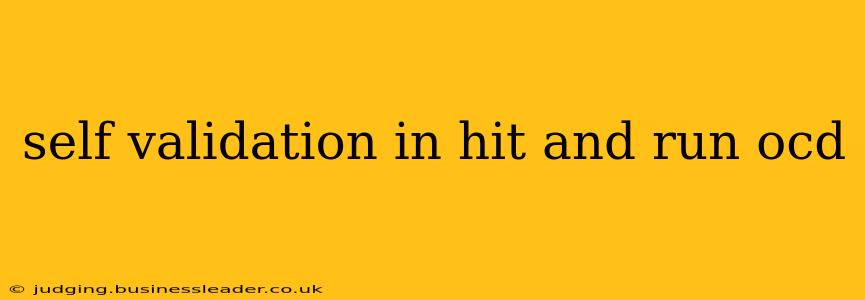Obsessive-Compulsive Disorder (OCD) can manifest in many ways, and one particularly distressing form involves intrusive thoughts centered around accidents, specifically hit-and-run scenarios. This type of OCD, often termed "hit-and-run OCD," causes individuals to experience intense anxiety and fear surrounding the possibility of unintentionally harming someone and then fleeing the scene. A crucial aspect of managing this challenging condition is understanding and implementing effective self-validation techniques.
This article explores the nature of hit-and-run OCD, the role of self-validation in managing it, and practical strategies to overcome these distressing intrusive thoughts.
What is Hit-and-Run OCD?
Hit-and-run OCD is characterized by recurring, unwanted thoughts about causing an accident, often involving a vehicle, and then leaving without providing assistance. These thoughts aren't based on actual events; rather, they are intrusive obsessions that trigger significant anxiety and distress. The individual may experience vivid mental imagery, replaying the hypothetical accident in their mind repeatedly. This can lead to compulsive behaviors, such as repeatedly checking to ensure no accidents occurred, avoiding driving, or seeking reassurance from others.
The core of this OCD subtype is the intense fear of being responsible for harm and the accompanying guilt and self-recrimination. The anxiety isn't about the possibility of actually causing an accident, but about the thought of it and the catastrophic consequences it represents in the sufferer's mind.
Why Does Self-Validation Matter in Hit-and-Run OCD?
Self-validation is critical in managing hit-and-run OCD because it directly addresses the underlying mechanism driving the anxiety. The intrusive thoughts are often interpreted as evidence of a deeper, underlying flaw or a prediction of future actions. Self-validation counters this by acknowledging the thoughts without giving them power. Instead of fighting the thoughts, you learn to accept them as merely thoughts—not reflections of your character or predictors of your behavior. This process helps reduce the compulsive behaviors aimed at reducing anxiety, ultimately breaking the cycle of obsession and compulsion.
It’s crucial to understand that having these intrusive thoughts doesn't mean you are a bad person or that you are likely to cause a hit-and-run. It's the OCD itself generating these fears, not a reflection of your character or likelihood to act on them.
How to Practice Self-Validation for Hit-and-Run OCD:
Here are some practical strategies for self-validation:
1. Recognizing and Labeling the Thoughts:
The first step is to identify the intrusive thoughts as just that—thoughts, not facts. When a hit-and-run thought arises, label it internally: "This is an OCD thought," or "This is just my anxiety talking." This simple act of labeling creates a mental distance between you and the thought, reducing its emotional impact.
2. Accepting the Thoughts Without Judgment:
Once you've labeled the thought, allow yourself to simply experience it without judgment or attempts to suppress it. Fighting the thought often intensifies it. Acceptance means acknowledging its presence without fighting it or trying to change it.
3. Challenging the Thought's Validity:
While accepting the thought's presence, you can also gently challenge its validity. Ask yourself: "Is this thought based on evidence? Is it likely to happen? What is the actual probability of this scenario?" Most often, the answer will be "no," reinforcing the fact that the thought is merely a product of your anxiety, not reality.
4. Focusing on Your Values and Actions:
Counteract the negative self-image that OCD attempts to create by focusing on your values and actions. Remind yourself of times you have acted responsibly and compassionately. This helps build a more balanced and accurate self-perception, mitigating the negative impact of OCD’s intrusive thoughts.
What if I have difficulty self-validating?
If you find it difficult to self-validate on your own, consider seeking professional help. A therapist specializing in OCD can guide you through techniques like Exposure and Response Prevention (ERP) therapy, which is a highly effective treatment for OCD. They can provide personalized support and coping mechanisms tailored to your specific needs and challenges.
Does self-validation cure Hit-and-Run OCD?
Self-validation, while a powerful tool, is typically part of a broader treatment plan. It’s not a standalone cure but rather a crucial component in managing the anxiety and compulsive behaviors associated with hit-and-run OCD. Combining self-validation with professional therapy and other coping mechanisms generally leads to the most significant improvement.
Is medication helpful for Hit-and-Run OCD?
In some cases, medication may be beneficial in conjunction with therapy. SSRIs (Selective Serotonin Reuptake Inhibitors) are often prescribed for OCD. However, medication should be discussed with a psychiatrist or other qualified healthcare professional, as it's not a one-size-fits-all solution.
By understanding the nature of hit-and-run OCD and actively employing self-validation techniques, individuals can begin to break free from the grip of these intrusive thoughts and regain a sense of control and peace of mind. Remember, seeking professional help is a sign of strength, not weakness, and it can be crucial in navigating the challenges of this specific form of OCD.
